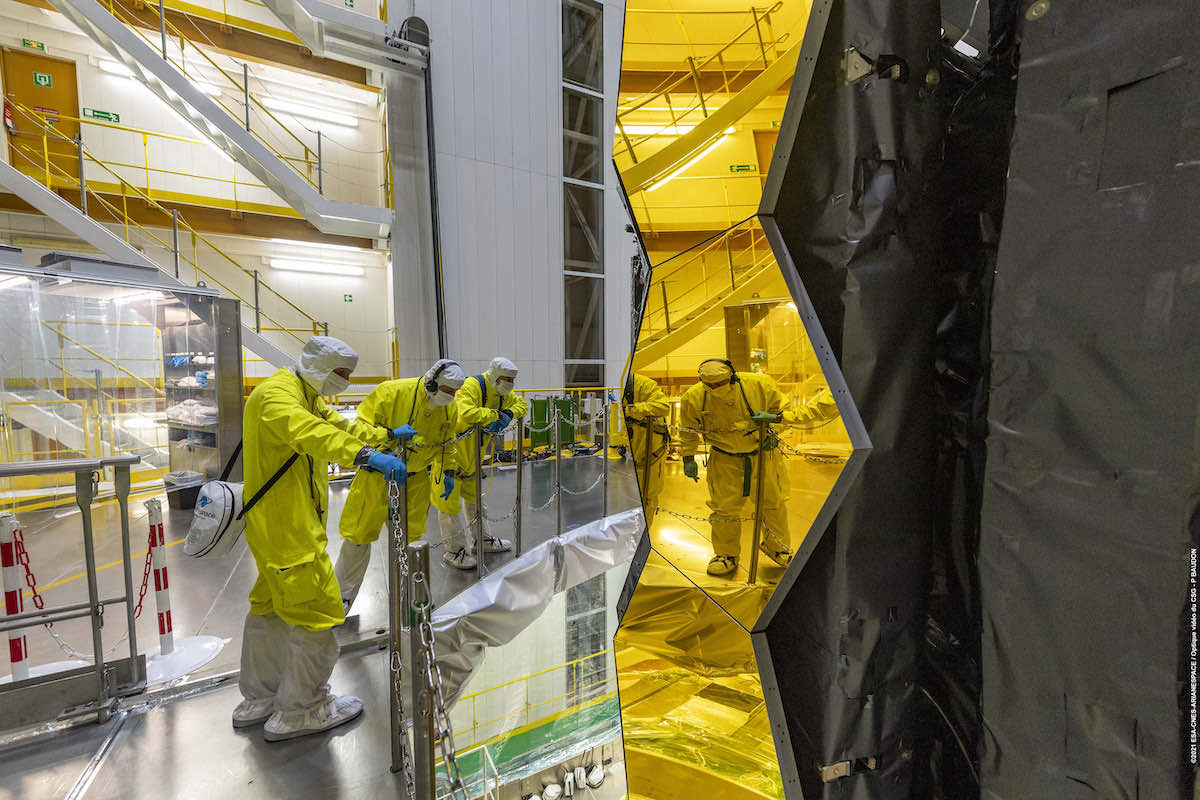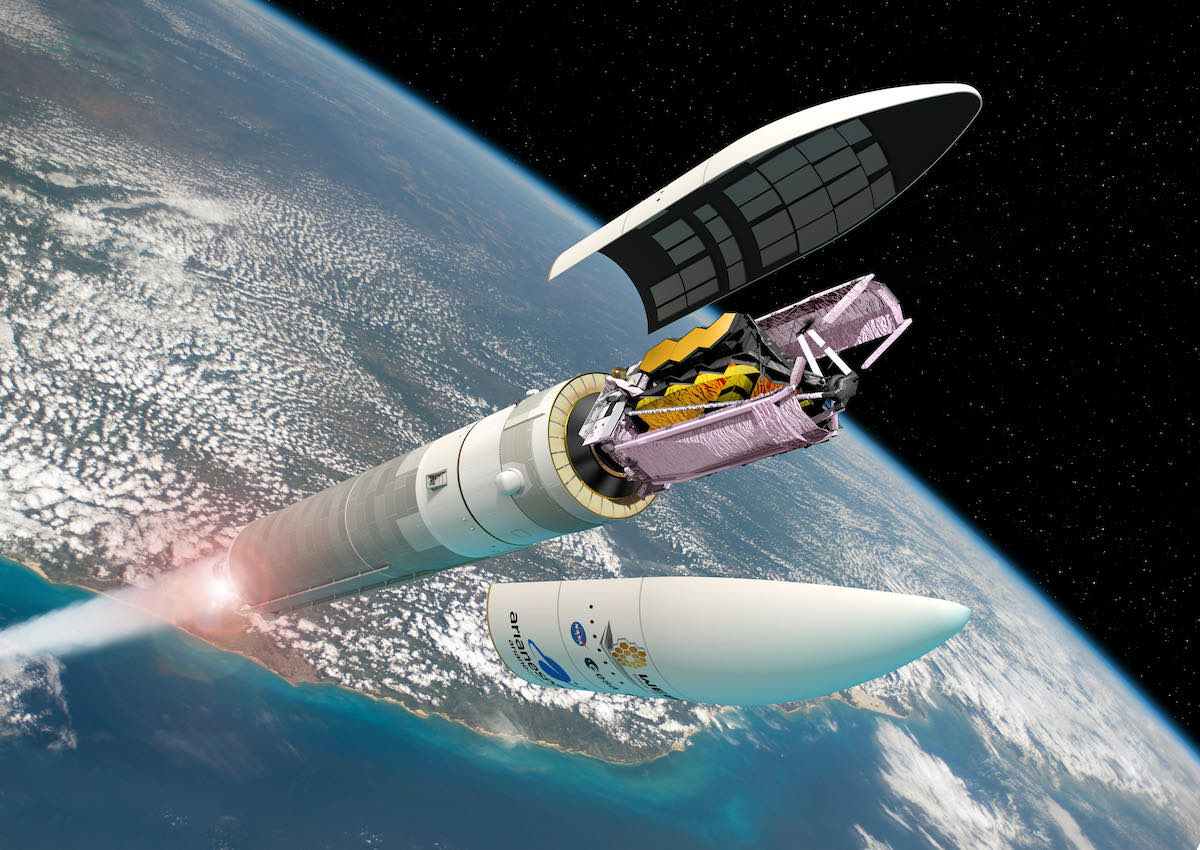Space News & Blog Articles
Launch of Webb telescope delayed to Christmas morning
 Mirror segments on the James Webb Space Telescope reflect members of the Ariane 5 and Webb teams in French Guiana. Credit: ESA/CNES/Arianespace/P. Baudon
Mirror segments on the James Webb Space Telescope reflect members of the Ariane 5 and Webb teams in French Guiana. Credit: ESA/CNES/Arianespace/P. Baudon
A poor weather forecast at the Guiana Space Center in South America has forced officials to delay the launch of the James Webb Space Telescope by one day to Dec. 25, Christmas morning, mission managers said Tuesday.
The 32-minute launch window Saturday opens at 7:20 a.m. EST (1220 GMT). Ground crews at the jungle spaceport in French Guiana planned to transfer the European Ariane 5 rocket with the Webb telescope on top to the ELA-3 launch zone Wednesday.
That rollout, expected to take about two hours, has been delayed to Thursday.
Managers from Arianespace, the Ariane 5’s launch operator, met with representatives from NASA, the European Space Agency, and the French space agency, CNES, for a launch readiness review Tuesday in French Guiana. The meeting covered the status of the Ariane 5 launcher, Webb, and the launch range at the French-run Guiana Space Center.
Officials gave the go-ahead at the end of the review to continue launch preparations, targeting a liftoff opportunity Friday morning. But managers decided to delay the launch by 24 hours after a weather briefing later Tuesday.
Heavy rain storms often batter the tropical spaceport on the northeastern coast of South America, but rainfall itself is not a constraint for an Ariane 5 launch. The main concerns watched by the Ariane 5 team include the risk of lightning and high-altitude winds.
If the winds are out of an unfavorable direction, they could blow toxic plumes and debris back over the the town of Kourou, just outside the gates of the space center. Range safety officials from CNES ensure winds are acceptable and within safety limits before every launch from the Guiana Space Center.
The three-story-tall Webb telescope is cocooned inside the Ariane 5 rocket’s Swiss-made payload fairing. The rocket will remain inside its vertical hangar, or final assembly building, until emerging for the 1.7-mile (2.7-kilometer) rollout o the launch pad.
Officials from NASA and ESA said another weather briefing is scheduled Wednesday to determine if teams should proceed with rollout Thursday for a launch Saturday morning.
The Ariane 5’s launch window opens at 9:20 a.m. local time in French Guiana.
 Artist’s illustration of the payload fairing jettisoning from an Ariane 5 rocket, revealing the James Webb Space Telescope. Credit: ESA/D. Ducros
Artist’s illustration of the payload fairing jettisoning from an Ariane 5 rocket, revealing the James Webb Space Telescope. Credit: ESA/D. Ducros
Webb is a $9.7 billion scientific instrument tuned to detect faint infrared light from the earliest galaxies in the universe. The observatory is the largest space telescope ever built, with 100 times the power of the 31-year-old Hubble Space Telescope.
It’s also the most expensive science mission ever sent into space, and it took more than a decade longer than originally predicted to design, build and ready for launch.
“This is an extraordinary mission,” said NASA Administrator Bill Nelson. “It’s a shining example of what we can accomplish when you dream big. We’ve always known that this project would be a risky endeavor, and of course, if you want a big reward, you have to usually take a big risk.
“And it’s one of the great engineering feats, not just at NASA and our international partners, but also for the people of this planet. This space telescope has been decades in the making. And as with most extraordinary projects that are transformative, there have been some speed bumps. There have been some setbacks along the way.”
Webb’s infrared telescope will also peer into stellar nurseries, where stars flash to life inside clouds of dust and gas opaque to observatories on the ground, or even Hubble, which observes primarily in the visible and ultraviolet parts of the spectrum.
And the giant telescope, once it unfolds to its final diameter of 21.3 feet (6.5 meters), will see planets around other stars will also unlike ever before. Webb’s spectroscopic instruments will look for signatures of the building blocks for life in their atmospheres.
“This is a once in a generation event,” said Pam Melroy, NASA’s deputy administrator. “NASA continues to push the boundaries of what’s possible, and this is such an exciting moment. For centuries, people have looked up at sky and dreamed of trying to understand the big questions. What was the start of the universe? And is there life out there beyond Earth?”
“Webb is going take the blinders off and show us the formation of the universe,” Melroy said. “This telescope represents the kind of public good for science and exploration for which our space program was established.”
This email address is being protected from spambots. You need JavaScript enabled to view it. the author.
Follow Stephen Clark on Twitter: @StephenClark1.
When you subscribe to the SpaceZE News Feed, we will send you an e-mail when there are new updates on the site so you wouldn't miss them.

